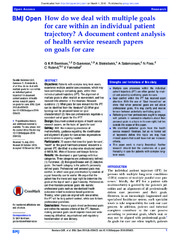How do we deal with multiple goals for care within an individual patient trajectory? A document content analysis of health service research papers on goals for care
Permanent lenke
https://hdl.handle.net/10037/8905Dato
2015-12-10Type
Journal articleTidsskriftartikkel
Peer reviewed
Forfatter
Berntsen, Gro Karine Rosvold; Gammon, Barbara Deede; Steinsbekk, Aslak; Salamonsen, Anita; Foss, Nina; Ruland, Cornelia; Fønnebø, VinjarSammendrag
Design: Document content analysis of health service research papers, on the topic of ‘goals for care’.
Setting: With the increasing prevalence of multimorbidity, guidance regarding the identification and alignment of goals for care across organisations and disciplines is urgently needed.
Participants: 70 papers that describe ‘goals for care’, ‘health’ or ‘the good healthcare process’ relevant to a general iPT, identified in a step-wise structured search of MEDLINE, Web of Science and Google Scholar.
Results: We developed a goal typology with four categories. Three categories are professionally defined: (1) Functional, (2) Biological/Disease and (3) Adaptive goals. The fourth category is the patient’s personally defined goals. Professional and personal goals may conflict, in which case goal prioritisation by creation of a goal hierarchy can be useful. We argue that the patient has the moral and legal right to determine the goals at the top of such a goal hierarchy. Professionals can then translate personal goals into realistic professional goals such as standardised health outcomes linked to evidence-based guidelines. Thereby, when goals are aligned with one another, the iPT will be truly patient centred, while care follows professional guidelines.
Conclusions: Personal goals direct professional goals and define the success criteria of the iPT. However, making personal goals count requires brave and widesweeping attitudinal, organisational and regulatory transformation of care delivery.


 English
English norsk
norsk